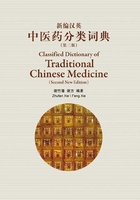
天人相应 Correspondence between Nature and Human
天人相应[tiān rén xiāng yìng]
correspondence between nature and human: one of the basic theories in traditional Chinese medicine, according to which the physical structure and physiological phenomena of the human body as well as its pathological changes are in adaptive conformity with the variations of the natural environment, and hence in diagnosis and treatment the influences of environmental factors such as climatic conditions and geographical localities should be taken into account
顺应四时[shùn yìng sì shí]
adaptation to seasonal changes: one of the major points in the theory of correspondence between nature and human that the human body should keep in adaptation to the climatic changes of the four seasons
因时制宜[yīn shí zhì yí]
taking measures that are suited to the time: a principle of treatment developed on the basis of the correspondence between nature and human that the patient should be treated in accordance with the climatic variations of the four seasons
因地制宜[yīn dì zhì yí]
taking measures that are suited to the place: a principle of treatment developed on the basis of the correspondence between nature and human that the patient should be treated in accordance with the geographical and climatic features of the relevalent area
运气学说[yùn qì xué shuō]
theory of the circuits and qi: the study of climatic changes and their relation to the occurrence of disease in terms of the five circuits and six qi
五运[wǔ yùn]
five circuits: collective term for the wood, fire, earth, metal and water circuits
六气[liù qì]
six qi: collective term for the six climatic phenomena, i.e., wind, cold, summerheat, dampness, dryness, and fire (heat)
五运六气[wǔ yùn liù qì]
five circuits and six qi: a traditional Chinese doctrine, based upon which meteorological features and changes as well as their effects on the human body can be predicted and calculated in terms of the Heavenly Stems and Earthly Branches
运气[yùn qì]
(I) circuit-qi: abbreviation for the five circuits and six qi (五运六气 [wǔ yùn liù qì]); (II) moving qi (see p. 503)
岁运[suì yùn]
circuit of year: the circuit qi that controls the meteorological features and changes of a given year as well as the corresponding prevalence of disease
主运[zhǔ yùn]
dominant circuit: the circuit of the regular seasonal changes of the climate
客运[kè yùn]
guest circuit: the circuit of the seasonal changes of the climate in a particular year
主气[zhǔ qì]
dominant qi: the qi that controls the regular seasonal changes of the climate
客气[kè qì]
guest qi: the qi that controls the seasonal changes of the climate in a particular year
间气[jiān qì]
intermediate qi: that part of guest qi,other than the qi responsible for celestial control and the qi with terrestrial effect, existing between Heaven and Earth
司天[sī tiān]
celestial control; controlling Heaven: the guest qi's control of the climatic changes in the first half of the year
在泉[zài quán]
terrestrial effect; affecting Earth: the guest qi's control of the climatic changes in the latter half of the year
岁会[suì huì]
annual congruence: periodic meeting of the circuit qi of the year with an earthly branch in terms of the five phases, happening in eight years of a sixty-year cycle
天符[tiān fú]
coincidence of heavenly qi: meeting of the circuit qi of the year with the qi controlling Heaven in terms of the five phases
平气[píng qì]
normal circuit qi: circuit qi that is neither excessive nor insufficient, rarely causing disease
天年[tiān nián]
natural life span: the length of time that a person is expected to live
天干[tiān gān]
heavenly stems: a sequence of ten symbols used as serial numbers and also in combination with the twelve earthly branches to designate years, months, days and hours
地支[dì zhī]
earthly branches: a sequence of twelve symbols used in combination with the ten heavenly stems to designate years, months, days and hours